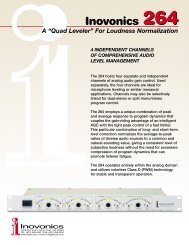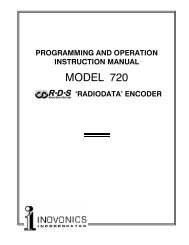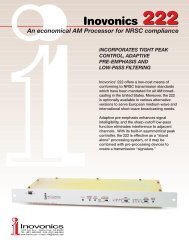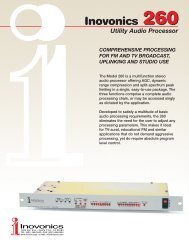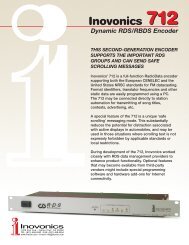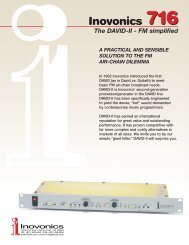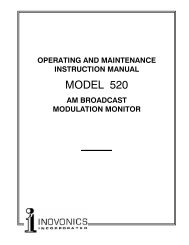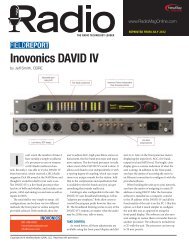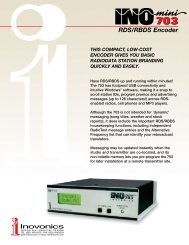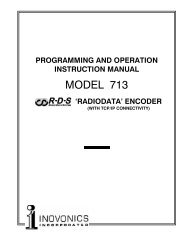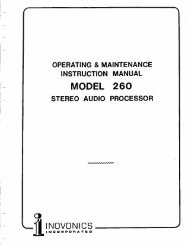Radio Magazine INOmini 632 Field Report - Inovonics
Radio Magazine INOmini 632 Field Report - Inovonics
Radio Magazine INOmini 632 Field Report - Inovonics
You also want an ePaper? Increase the reach of your titles
YUMPU automatically turns print PDFs into web optimized ePapers that Google loves.
www.<strong>Radio</strong>MagOnline.com<br />
THE RADIO TECHNOLOGY LEADER<br />
Reprinted from APRIL 2012<br />
fieldreport<br />
Displays essential RDS<br />
and HD <strong>Radio</strong> PAD<br />
Analog and AES3 outputs<br />
Front-panel alarms<br />
and rear-panel tallies<br />
<strong>Inovonics</strong><br />
<strong>INOmini</strong> <strong>632</strong><br />
by Barry Thomas, CPBE CBNT<br />
THE RADIO TECHNOLOGY LEADER<br />
ne surprisingly challenging issue<br />
O<br />
with operating HD <strong>Radio</strong> technology,<br />
especially using FM HD <strong>Radio</strong><br />
multicast channels, is cost-effective<br />
and professional monitoring. There are elaborate<br />
devices, modulation monitors and test equipment<br />
that poll, sample and test HD <strong>Radio</strong> signals but<br />
there’s been a great need for inexpensive, straightforward<br />
monitoring of the station’s digital signals.<br />
The need for this sort of monitoring made<br />
for one of the most anticipated products from<br />
the <strong>Radio</strong> magazine Pick Hits of the 2011 NAB<br />
Show: The <strong>Inovonics</strong> <strong>INOmini</strong> <strong>632</strong> FM and<br />
FM/HD <strong>Radio</strong> monitor/receiver. Although the<br />
unit was shown in the spring, Ibiquity certification<br />
took a little longer than expected. The<br />
reason is apparently related to some of the most<br />
useful and important features of the receiver.<br />
The <strong>INOmini</strong> form factor is 1RU by 1/3 rack<br />
space width. The <strong>632</strong> is specifically designed to<br />
monitor FM HD <strong>Radio</strong> in professional radio<br />
station environments. The unit can demodulate<br />
analog and decode HD <strong>Radio</strong> (including multicast)<br />
channels. The front-panel display is a selectable<br />
readout showing frequency, channel, signal<br />
strength, left and right audio meters, RDS (PI,<br />
PS, PTY, RT and even RT+!) or HD <strong>Radio</strong> PAD<br />
800-733-0552<br />
inovonicsbroadcast.com<br />
sales@inovon.com<br />
inovonics<br />
Receives FM analog and<br />
HD <strong>Radio</strong> broadcasts<br />
(name, type, lname, artist, title). The audio output<br />
uses XLR males for analog and AES/EBU, and a<br />
4-pin Phoenix connector with one ground and<br />
three open-collector alarm outputs that indicate<br />
carrier loss, digital loss and audio loss.<br />
The <strong>632</strong> is powered using an external supply.<br />
Using the parallel power jacks and a supplied<br />
dc jumper, up to three units can be daisy<br />
chained to help manage wall-wart congestion in<br />
equipment racks.<br />
Open the box<br />
When I received the unit I did what just<br />
about any engineer would do: I opened the box,<br />
plugged it in and connected an antenna and<br />
a set of headphones. In fact even the manual<br />
anticipated that reaction:<br />
“If, like most of us, you’ve allowed youthful<br />
enthusiasm to override methodical procedure,<br />
you’ve either already figured out the <strong>632</strong> receiver<br />
menu for yourself, or you are ready to throw this<br />
unit under the wheels of a passing locomotive.”<br />
This unit isn’t coming close to a CSX line<br />
any time soon. As thoroughly articulated in the<br />
user’s manual, the <strong>632</strong> is extremely simple to<br />
understand and operate. There’s a single knob for<br />
navigation and control. Turn the knob to move a<br />
flashing cursor, press the knob to select, turn the<br />
knob to adjust, and then press again to set/exit.<br />
LCD screen and<br />
jog-wheel navigation<br />
Receiver mode can be manually selected<br />
and “forced”: analog stereo (blend or no blend),<br />
analog mono, HD-1, HD-2, or HD-3 all the<br />
way (theoretically) to HD-8. Considering that<br />
a very common implementation of FM HD <strong>Radio</strong><br />
with multicast uses three digital channels,<br />
(HD-1 to HD-3), the <strong>INOmini</strong> size makes it so<br />
all an FM station’s digital on-air channels can<br />
be monitored in a single rack space (and with a<br />
single power plug, but more on that later).<br />
For a small monitor, the <strong>632</strong> display can<br />
show an impressive amount of information. The<br />
normal, idle display shows the frequency, mode<br />
(FM:M/S, HD-1 ... HD-8), RBDS PI Code (raw<br />
and decoded per NRSC-4 specifications) when<br />
in analog mode and or name field on HD <strong>Radio</strong><br />
mode. The small signal strength meter changes<br />
to a DQ (digital quality) meter in HD <strong>Radio</strong><br />
mode.<br />
When an alarm condition occurs such as<br />
the station losing the HD <strong>Radio</strong> signal, audio<br />
failure or carrier failure, the front panel flashes<br />
Low Signal, Audio Loss or HD Loss, and also<br />
triggers the appropriate alarm outputs on the<br />
rear panel. Even if the alarm outputs are not<br />
used, the flashing front panel should attract the<br />
attention of a passing engineer. Pressing the<br />
front panel knob mutes the display but the rear<br />
panel alarm remains triggered and will do so<br />
Copyright 2012 NewBay Media (USA), LLC. Reprinted with permission.
until the alarm condition is cleared (digital carrier,<br />
audio or analog carrier restored).<br />
Beyond HD <strong>Radio</strong><br />
Although the device isn’t specifically an<br />
RBDS or HD <strong>Radio</strong> PAD data analysis tool,<br />
the most common and visible RBDS Data and<br />
HD <strong>Radio</strong> PAD fields can be manually selected<br />
and displayed. If, for example you are tweaking<br />
RBDS transmission percentages, field padding,<br />
repetition rates, individual fields can be cleared<br />
and redisplayed. In FM analog mode, the PI<br />
code display even seems to clear and redisplay<br />
each time the receiver decodes the transmission.<br />
Even <strong>Radio</strong>text + fields are displayed and<br />
there are similar pages for the similar HD <strong>Radio</strong><br />
PAD fields (name, type, artist, title). These<br />
features are a big improvement over waiting for<br />
consumer RDS or HD <strong>Radio</strong> display time-outs<br />
and display refreshes. As stations get more<br />
sophisticated in how their HD <strong>Radio</strong> PAD and<br />
RBDS data is used, this can become a very useful<br />
feature for spot checks.<br />
The carrier loss alarm trigger level is set<br />
immediately below the signal strength meter on<br />
the same display page. The audio loss (silence<br />
sense) alarm can be disabled or a delay can be<br />
set from 1-120 seconds. There’s no adjustment<br />
for HD loss but the alarm will trigger if HD<br />
<strong>Radio</strong> mode is selected and after a delay of a<br />
few seconds after loss of digital signal.<br />
Many of us have anticipated the release of<br />
the <strong>632</strong> ever since it was awarded a <strong>Radio</strong> magazine<br />
Pick Hit, but sale of the unit was pending<br />
certification by iBiquity. What made certification<br />
difficult was that certain features critical<br />
to HD <strong>Radio</strong>’s success on a consumer level are<br />
actually limitations for professional equipment.<br />
Fortunately the <strong>632</strong> was licensed by iBiquity<br />
in January 2012 under a “limited certification”<br />
because of the following variances, specified in<br />
the unit’s documentation:<br />
> The <strong>Inovonics</strong> <strong>632</strong> displays only four characters<br />
of call sign (not all six characters as defined<br />
in the requirements.)<br />
> The <strong>Inovonics</strong> <strong>632</strong> displays only 39 characters<br />
of artist (not 64 characters as defined in the certification<br />
requirements supporting the ID3v2.3<br />
standard.)<br />
> The <strong>Inovonics</strong> <strong>632</strong> displays only 39 characters<br />
of title (not 64 characters as defined in the certification<br />
requirements supporting the ID3v2.3<br />
standard.)<br />
In addition the <strong>632</strong> is inhibited from blending<br />
to analog. This means the <strong>632</strong> is actually a<br />
real, honest-to-goodness air monitor for the<br />
digital channels. The receiver can be set to<br />
avoid the typical consumer analog stereo blend.<br />
I’ve excerpted the user’s manual a couple of<br />
times. The excellent technical writing is worth<br />
recognition. For such a simple, easy-to-use device,<br />
the user’s manual is exceptionally complete<br />
and accurate. For all this I thank <strong>Inovonics</strong>.<br />
There are two items I would like to see<br />
added. The selection between FM and HD<br />
modes is done from the idle display, however<br />
the FM stereo/mono/blend/no-blend selection<br />
is done a few pages away in the menus. It would<br />
be useful for the initial mode selection to be in<br />
one place: FM auto, mono, stereo, HD-1, etc.,<br />
even if the blend setting were in a different<br />
menu location.<br />
I would also like to see IP integration. Either<br />
an internal network connection or an optional,<br />
add-on device that would echo the alarm functions<br />
using SNMP, maybe even an email or SMS<br />
client to send alarms.<br />
It’s likely that either of my desired features<br />
may not be possible within the reasonable price<br />
point offered for the monitor. The features<br />
above in no way detract from an otherwise<br />
excellent monitoring product for analog but<br />
especially for FM HD <strong>Radio</strong> channels.<br />
For the use of cost-effective, dedicated<br />
HD <strong>Radio</strong> monitoring, the <strong>INOmini</strong> <strong>632</strong> is<br />
a problem-solver that I expect will become a<br />
fixture at stations nationwide very soon.<br />
Thomas is vice president of engineering,<br />
Lincoln Financial Media, Atlanta.<br />
Copyright 2012 NewBay Media (USA), LLC. Reprinted with permission.<br />
Reprinted from <strong>Radio</strong>



